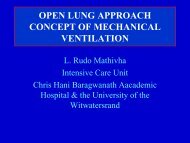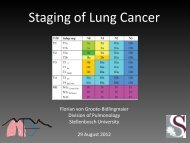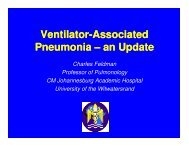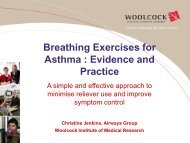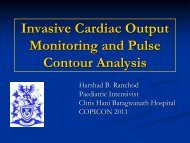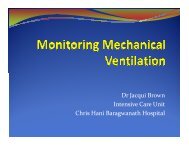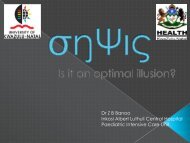Greg Calligaro Definition and classification of pulmonary hypertension
Greg Calligaro Definition and classification of pulmonary hypertension
Greg Calligaro Definition and classification of pulmonary hypertension
- No tags were found...
You also want an ePaper? Increase the reach of your titles
YUMPU automatically turns print PDFs into web optimized ePapers that Google loves.
<strong>Definition</strong> <strong>and</strong><strong>classification</strong> <strong>of</strong><strong>pulmonary</strong> <strong>hypertension</strong><strong>Greg</strong> <strong>Calligaro</strong>Division <strong>of</strong> PulmonologyGroote Schuur HospitalUCT Lung Institute
Pulmonary<strong>hypertension</strong>
Haemodynamic definition <strong>of</strong> <strong>pulmonary</strong><strong>hypertension</strong>PHMean PAP ≥25 mmHg (rest)• As assessed by right heart catheterisation (RHC)• Value used in registries <strong>and</strong> RCTs• Normal mPAP 14±3mmHg (ULN 20mmHg)• <strong>Definition</strong> <strong>of</strong> mPAP>30mmHg on exercise hasbeen dropped• ACCP/AHA also include a PVR > 3 Wood unitsBadesch et al. JACC, 2009.
Haemodynamic definition <strong>of</strong> <strong>pulmonary</strong><strong>hypertension</strong>PHMean PAP ≥25 mm HgPre-capPHPost-capPHMean PAP ≥25 mm Hg plusPCWP/LVEDP ≤15 mm HgMean PAP ≥25 mm Hg plusPCWP/LVEDP >15 mm HgBadesch D et al. J Am Coll Cardiol. 2009;54:S55-S66.McLaughlin VV et al. J Am Coll Cardiol. 2009;53:1573-1619.Badesch et al. JACC, 2009.Halpern SD, et. al. Chest, 2009.
PH: importance <strong>of</strong> PCWP• Identifies patients with PH due to leftheart disease• An accurate PCWP can be difficultto obtain in patients with PH <strong>and</strong>enlarged <strong>pulmonary</strong> arteries• Patients with PCWP ≥ 15mmHgshould have their LVEDP directlymeasured by left heartcatheterisation (LHC)• A recent retrospective study <strong>of</strong>subjects undergoing both RHC <strong>and</strong>LHC showed that 5% <strong>of</strong> patientswith elevated PCWP had normalLVEDPHalpern SD, et. al. Chest, 2009.
Classification <strong>of</strong> PH• Evolution <strong>of</strong> the <strong>classification</strong> <strong>of</strong> PH:– Pre-capillary vs. post-capillary- “Primary” vs. “secondary”– WHO <strong>classification</strong>:groups with similar natural histories,pathologies <strong>and</strong> treatments
WHO Group 1 PAH1. PAH•Idiopathic PAH•Heritable•Drug- <strong>and</strong> toxin-induced•Associated with:−CTD−HIV infection−portal <strong>hypertension</strong>−CHD−schistosomiasis−chronic hemolytic anemia• Persistent PH <strong>of</strong> newborn• Consists <strong>of</strong> IPAH, heritablePAH (BMPR2 <strong>and</strong> ALK1genes)• Drugs <strong>and</strong> toxin-inducedPAH:– Definite: aminorex,fenfluramine, toxic rapeseedoil– Likely: amphetamines, L-tryptophan, cocaine, St.John’s Wort, SSRI’sSimonneau G et al. J Am Coll Cardiol. 2009;54;S43-S54.
Group 1: PAH associated with CT disease• Connective tissue diseases:– limited scleroderma (most common)– diffuse scleroderma– systemic lupus erythematosus– Sjogren’s syndrome– rheumatoid arthritis– MCTD• PH is an important cause <strong>of</strong> death in scleroderma (2 nd toILD); recommend yearly screening• Similar to IPAH pathology• Medical treatment same as for IPAH, but benefits lessthan for IPAHHachulla E et al. Rheumatology, 2009.
Group 1: PAH associated with HIV infection• Prevalence <strong>of</strong> 0.5-0.8%• One study found that 35% <strong>of</strong> HIV-infected patients hadPASP>30mmHg• No relationship with CD4 count or VL• Pathogenic findings: plexogenic <strong>pulmonary</strong> arteriopathyHsue et. al., AIDS, 2008Mehta et. al., Chest, 2000
HIV-associated PAH: pathogenesisStimulation <strong>of</strong>cytokines <strong>and</strong>growth factors bychronic HIVinfectionTat protein:excessendothelialgrowth viaBMPR2Nef protein:potential role inplexiform lesionsStimulation <strong>of</strong>endothelin bygp120?co-infectionwith HHV-8Marecki et. al., ARJCCM, 2006M<strong>and</strong>ell et. al., Virology, 1999
PAH related to portal <strong>hypertension</strong>• Prevalence <strong>of</strong> 2-5% by RHC: up to 17% in livertransplant c<strong>and</strong>idates• Related to degree <strong>of</strong> porto-systemic shunting, notunderlying hepatocellular dysfunction• Worse mortality than IPAH alone• Liver transplant may improve survival (if mild tomoderate PH) - (28-56% 5 year survival)Budhiraja R et al. Chest. 2003.Kawut SM et al. Liver Transpl. 2005.Krowka MJ et al. Clin Chest Med. 2005.
Group 1: Congenital heart disease• Pulmonary blood volumeoverload from intracardiacshunting• Left-to-right shunts are mostcommon, especially VSDs• PAH can also occur in patientswith ASDs
PAH related to schistosomiasis• Pathogenesis originallythought to be embolic• Plexiform lesions observedin pathological studies• Portal <strong>hypertension</strong>independent risk factor• Egg impaction may act astrigger for:– oxidative stress– inflammation– endothelial dysfunctionRoss E et al. NEJM, 2002.
Group 1: PAH associated with haemolysis• Sickle cell disease (SCD)most important sub-group• Prevalence <strong>of</strong> PH in patientswith sickle cell diseasereported on echo studies as±30%• Much lower on RHC: ±5%• Free Hb scavenges NO –induces state <strong>of</strong> resistanceto NO bioactivity• Also associated withplexiform lesionsGladwin MT, NEJM, 2004.
Group 1’: PVOD <strong>and</strong> PCH• Ground glass opacities, septal thickening <strong>and</strong>mediastinal lymphadenopathyResten et. al, AJR, 2004.
Group 1’: PVOD <strong>and</strong> PCH• Vasodilator-induced <strong>pulmonary</strong> oedema can occur due toincreased driving pressure <strong>and</strong> post-capillary obstructionHumbert et. al., AJRCCM, 1998.Resten et. al., Radiology, 2002.
Changes to WHO Group 1 (Dana Point 2008)• “Familial” replaced by “heritable”• Classification <strong>of</strong> congenital heart disease was updated• Chronic haemolytic anaemias listed as own group under“associated PAH”• PVOD/PCH given its own group, related to group 1 (1’)• Schistosomiasis moved from embolic group (Group 4)• Rarer causes (thyroid disease, Gaucher’s etc.) moved togroup 5
Group 2: Left heart disease1. PAH• Idiopathic PAH• Heritable• Drug- <strong>and</strong> toxin-induced• Associated with:−CTD−HIV infection−portal <strong>hypertension</strong>−CHD−schistosomiasis−chronic hemolytic anemia• Persistent PH <strong>of</strong> newborn• Any cause <strong>of</strong> left atrial<strong>hypertension</strong>:– systolic or diastolicdysfunction– valvular heart disease– constrictive pericarditis– restrictive CMO– left atrial myxoma1’. PVOD <strong>and</strong>/or PCH2. PH due to Left Heart Disease• Systolic dysfunction• Diastolic dysfunction• Valvular disease
Group 2: Left heart diseaseNormalTightmitralstenosisSVCIVCRA RV PAPC MVA=4.0 cm 2PV LA LV AoFLOW6L/min5 5 20/5 20/8 (12) 6 6 6 120/6120/8Without PVDMVA=1.0 cm 25 5 45/5 45/25 (32) 25 25 25 120/5FLOW5L/minTightmitralstenosisWith PVD20 20130/20130/80 (100) 30 30 30 110/5FLOW3L/min
Group 3: Secondary to lung disease/hypoxia• PH is a commoncomplication <strong>of</strong> COPD, butis usually mild• Also mild PH with OSA;becomes significant ifcombined with OHS orother cause <strong>of</strong> hypoxaemia• ILD another importantcategory3. PH due to Lung Diseases <strong>and</strong>/or Hypoxia•COPD•ILD•Other <strong>pulmonary</strong> diseases with mixedrestrictive <strong>and</strong> obstructive pattern•Sleep-disordered breathing•Alveolar hypoventilation disorders•Chronic exposure to high altitude•Developmental abnormalitiesSimonneau G et al. J Am Coll Cardiol. 2009;54;S43-S54.
Group 3: Secondary to lung disease/hypoxia• PH is a commoncomplication <strong>of</strong> COPD, butis usually mild• Also mild PH with OSA;becomes significant ifcombined with OHS orother cause <strong>of</strong> hypoxaemia• ILD another importantcategory• Mechanism: HPV3. PH due to Lung Diseases <strong>and</strong>/or Hypoxia•COPD•ILD•Other <strong>pulmonary</strong> diseases with mixedrestrictive <strong>and</strong> obstructive pattern•Sleep-disordered breathing•Alveolar hypoventilation disorders•Chronic exposure to high altitude•Developmental abnormalitiesSimonneau G et al. J Am Coll Cardiol. 2009;54;S43-S54.
Group 4: Chronic thromboembolic PH• Occurs in 2-4% <strong>of</strong> patientfollowing acute PE• However, up to two thirds<strong>of</strong> patients with CTEPH willhave no history <strong>of</strong> previousVTE• V/Q scanning is thediagnostic modality <strong>of</strong>choice3. PH due to Lung Diseases <strong>and</strong>/or Hypoxia•COPD•ILD•Other <strong>pulmonary</strong> diseases with mixedrestrictive <strong>and</strong> obstructive pattern•Sleep-disordered breathing•Alveolar hypoventilation disorders•Chronic exposure to high altitude•Developmental abnormalities4. CTEPH5. PH With Unclear Multifactorial Mechanisms•Hematologic disorders•Systemic disorders•Metabolic disorders•OthersKlok FA, et. al. Prospective screening program to detect CTEPH following PE. Haem, 2010.Dentali F, et. al. Incidence <strong>of</strong> CTEPH after first episode PE. Thromb Res, 2009.
Group 4: CTEPH• Most <strong>pulmonary</strong> emboli resolve without sequelae• A minority <strong>of</strong> patients will develop chronicthromboembolic <strong>pulmonary</strong> <strong>hypertension</strong> (CTEPH)• CTEPH is defined as a mPAP greater than 25mmHg thatpersists 6 months after an acute PE• Occurs in 2-4% <strong>of</strong> patient following acute PE• However, up to two thirds <strong>of</strong> patients with CTEPH willhave no history <strong>of</strong> previous VTEKlok FA, et. al. Prospective screening program to detect CTEPH following PE. Haem, 2010.Dentali F, et. al. Incidence <strong>of</strong> CTEPH after first episode PE. Thromb Res, 2009.
PathophysiologyPATENT VESSELS:Remodelled withplexiform lesionsOBSTRUCTEDVESSELS:Normal“downstream”histologyPiazza G et al, Chronic thromboembolic <strong>pulmonary</strong> <strong>hypertension</strong>. NEJM, 2011.Hoeper M et al, Chronic Thromboembolic Pulmonary Hypertension, Circulation 2006.
Pathophysiology• “Two compartment <strong>pulmonary</strong> vascular bed” model:– one compartment obstructed by organising thrombus,but with normal downstream vessel calibre <strong>and</strong>histology– one compartment exposed to increased flow,increased shear stresses remodelling <strong>of</strong> smallarteries predisposition to thrombosisHigh PAP = sum <strong>of</strong> proximal PEs +distal small vessel arteriopathyHoeper M et al, Chronic Thromboembolic Pulmonary Hypertension, Circulation 2006.
Group 4: CTEPH• Surgery is the only definitive therapy for CTEPH –<strong>pulmonary</strong> thromboendarterectomy (PEA) is procedure <strong>of</strong>choice• Decision to proceed to PEA is based on:– accessibility <strong>of</strong> the thrombi– presence <strong>of</strong> haemodynamic ± ventilatory impairment– willingness <strong>of</strong> the patient– other comorbidities
Group 4: CTEPH
Treatment: surgery• If successful, PEA improves:- haemodynamics (meanreduction in PVR 65%)- WHO functional classimproves by 2 classes- exercise capacity (6MWD,CPET)BEFOREAFTER• Peri-operative mortality is about10%Corsico AG et al, Long term outcome after PEA. ARJCCM, 2008Matsuda H et al, Long term recovery <strong>of</strong> exercise capacity after PEA for CTEPH. Circulation, 2009.
Group 5: Unclear or multifactorial mechanisms• Heterogeneous collection<strong>of</strong> diseases with uncertainpathogeneticmechanisms3. PH due to Lung Diseases <strong>and</strong>/or Hypoxia•COPD•ILD•Other <strong>pulmonary</strong> diseases with mixedrestrictive <strong>and</strong> obstructive pattern•Sleep-disordered breathing•Alveolar hypoventilation disorders•Chronic exposure to high altitude•Developmental abnormalities4. CTEPH5. PH With Unclear Multifactorial Mechanisms•Hematologic disorders•Systemic disorders•Metabolic disorders•Others
Group 5: Unclear or multifactorial mechanisms• Haematological disorders: myeloproliferative disorders,splenectomy• Systemic disorders: sarcoidosis, PLCH, LAM,neur<strong>of</strong>ibromatosis, vasculitis• Metabolic disorders: glycogen storage disease, Gaucher’sdisease, thyroid disease• Others: tumor obstruction, fibrosing mediastinitis, CRF ondialysisSimonneau G et al. J Am Coll Cardiol. 2009.
Summary• Pulmonary <strong>hypertension</strong> is defined by a mPAP >25mmHg at rest• WHO classifies PH into 5 groups, based on aetiology,natural history, prognosis <strong>and</strong> treatment• “Pulmonary arterial <strong>hypertension</strong>” (PAH) describesgroup 1: this includes heritable, drug-induced <strong>and</strong>“associated with” aetiologies• CTEPH is important to identify; treatment could besurgical
Acknowledgements• Pulmonary Hypertension Association:www.phassociation.org



